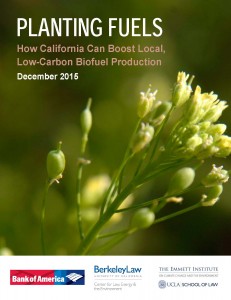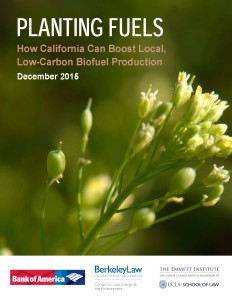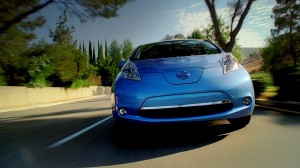Much of our efforts to reduce carbon emissions involves fairly complicated and advanced technologies. Whether it’s solar panels, batteries, flywheels, or fuel cells, these technologies have typically required public support to bring them to scale at a reasonable price, along with significant regulatory or legal reforms to accommodate these new ways of doing old things, from generating power to driving a car.
Yet ironically, here in California we seem to be making the most progress on some of these more technologically advanced areas, and not enough progress in one of the simplest and most cost-effective means of reducing carbon emissions: using less energy in our existing buildings.
Being more energy efficient certainly can involve technological advances, like LED lights instead of incandescent bulbs, lights with sensors that turn off when people leave a room, or more efficient heating or air conditioning units. But it is fundamentally about doing the same with less, and it can often pretty quickly pay off, given the reduction in utility bills that result.
But in California, despite billions spent on energy efficiency efforts, our energy efficiency efforts are barely keeping pace with the increasing demand for electricity. Current utility efficiency programs focus on voluntary, often self-financed measures, with rebates and fixed incentives meant to spur them on. Meanwhile, administrator costs are taking up half of the budgets for many efficiency programs.
Clearly, something needs to change if we are to have any hope of achieving our long-term climate and energy goals in the state. After all, it’s a waste to focus on expensive new renewables and energy storage if we’re not making better progress on the efficient use of the energy we already have.
Given this challenge, the state legislature recently acted to change the nature of our efficiency programs. SB 350 (De Leon, 2015) requires a doubling of efficiency in our buildings by 2030, while AB 802 (Williams, 2015) in part requires utilities to plan for efficiency programs that compensate building owners based on the measured energy saved. These steps will be necessary to change the paradigm and unlock more private investment in energy efficiency retrofits.
To recommend policies to boost this capital market financing for energy retrofits, UC Berkeley and UCLA Law are today releasing a new report “Powering the Savings: How California Can Tap the Energy Efficiency Potential in Existing Commercial Buildings.” The report is the 17th in the two law schools’ Climate Change and Business Research Initiative, generously supported by Bank of America since 2009.
The report describes ways that California could unlock more private investment in energy efficiency retrofits, particularly in commercial buildings. This financing will flow if there’s a predictable, long-term, measured and verified amount of savings that can be directly traced to energy efficiency measures. New software and methodologies can now more accurately perform this task. They establish a building’s energy performance baseline, calibrating for a variety of factors, such as weather, building use, and occupancy changes. That calibrated or “dynamic” baseline can then form the basis for calculating the energy savings that occur due specifically to efficiency improvements.
But the state currently lacks a uniform, state-sanctioned methodology and technology standard, so utilities are reluctant to base efficiency incentives or programs without regulatory approval to use these new methods. The report therefore recommends that energy regulators encourage utilities to develop aggressive projects based on these emerging metering technologies that can ultimately inform a standard measurement process and catalyze “pay-for-performance” energy efficiency financing, with utilities able to procure energy efficiency savings just like they were a traditional generation resource.
To learn more about the report and its recommendations, please join us for a webinar on Monday, April 18th from 10 to 11am. Speakers will include:
- Jeanne Clinton, Special Advisor to Governor Brown for Energy Efficiency, California Public Utilities Commission
- Cynthia Mitchell, energy economist and TURN consultant
- Dennis Quinn, Chief Operating Officer and Co-Founder, Joule Assets. Inc.
You can register via this site.
Hopefully, by tapping into the state’s spirit of innovation, California leaders can show the way to an energy efficiency revolution the way the state helped create a strong market for other clean technologies, like solar panels and energy storage. Because failure on the efficiency front could otherwise nullify so much of our progress in these other areas.
 Last week I keynoted the California Biodiesel Conference in Sacramento, and I learned a lot from the panel presentations. The organizers have how made all the slides available here (scroll down a bit).
Last week I keynoted the California Biodiesel Conference in Sacramento, and I learned a lot from the panel presentations. The organizers have how made all the slides available here (scroll down a bit).
You can learn about the Governor’s Office priorities for funding more in-state biodiesel production, why gasoline consumption is projected to decline but diesel consumption to rise in the coming decades, and why biodiesel is one of the fastest growing biofuels in use in California, among other interesting tidbits.
And if that’s not enough, read our Berkeley / UCLA Law report Planting Fuels to learn about policies that could boost in-state production even more.
While electrification of transportation will be desirable for passenger vehicles and some goods movement, ultimately we’ll still need biofuels for many transportation needs, from long-haul trucking to aviation. Low-carbon biodiesel will therefore be a key part of our fuel mix for the foreseeable future.
The future of a clean electricity grid will require more decentralization based on clean technology, like solar and energy storage. Large industrial customers are investing in these technologies and also signing up to moderate their electricity demand in response to larger grid needs (i.e. reducing usage when electricity becomes expensive and dirty to produce). Smaller users like homeowners can become part of a bundled, aggregated group that can produce the same effect as a single large user through automated software and payments that encourage reduced demand at key times.
Under an important federal regulation by the Federal Energy Regulatory Commission (FERC) back in 2011, clean tech companies sell this aggregated change in demand (called “demand response”) to regional grid operators as a package deal. The reduced demand that these companies bundle helps to alleviate strain on the grid, lower economic costs on the wholesale power market, and reduce pollution in the process.
But as I wrote in October, the future of this arrangement was in doubt, with the Supreme Court considering a major challenge to the legality of FERC’s order 745, which enabled this aggregated demand response. The issue is that states control their in-state retail market, while the federal government through FERC can only regulate the wholesale power market across state lines. When FERC allowed clean tech companies to bundle changes in user demand through retail price signals and then sell that aggregated change in demand to regional grid operators in the wholesale power market, opponents argued that FERC was overstepping its bounds into areas under state jurisdiction. Think of it like a commerce clause challenge to FERC authority.
Fortunately, the Supreme Court decided today in a 6-2 vote (Alito recused himself, with Scalia and Thomas dissenting) that FERC’s order was a legitimate regulation under the agency’s wholesale interstate market jurisdiction. As Justice Kagan wrote:
It is a fact of economic life that the wholesale and retail markets in electricity, as in every other known product, are not hermetically sealed from each other. To the contrary, transactions that occur on the wholesale market have natural consequences at the retail level. And so too, of necessity, will FERC’s regulation of those wholesale matters.
The court found that FERC can regulate in areas that directly affect the wholesale power market, as in this demand response arrangement, and that a scheme to provide payments for users to moderate demand and then sell it on the wholesale power market does not constitute a direct setting of in-state retail rates, which would otherwise be under state jurisdiction.
The implications of this decision are critical not just for demand response but for other clean technologies as well. As states look to broaden their clean technology base outside of their boundaries, they’re going to need federal regulations to enable interstate coordination, sometimes grounded at the local level. For example, just as customers can aggregate their retail demand changes to sell to the wholesale power market, they may want to aggregate their on-site energy storage such as using the Tesla PowerWall battery. Or they may want to aggregate power they return to the grid from their plugged-in electric vehicles. Or they may want to share surplus solar power from their roofs across state lines.
The possibilities are myriad and all indispensable to a technology-driven approach to decarbonizing our grid. With the Court’s decision today, this innovation can continue, leading to further economic and environmental benefits for all electricity ratepayers.
Just in time for our lunch event on biofuels today, the Navy this week announced a major investment in biofuels for its fleet, per the San Diego Union-Tribune:
This Wednesday, there surely will be tears, hugs and excitement as sailors begin another deployment to the world’s hotspots. On the surface, it will be a replay of a common occurrence in any Navy town when sailors go to sea, but in the ships’ gas tanks will be fuel made from renewable resources that has officials back at the Pentagon exuberant.
“Underway on beef-fat power” might not have the same ring as “Underway on nuclear power,” the historic message the Nautilus submarine beamed when it left the pier 61 years ago today. Nonetheless, the Navy is trumpeting the use of renewable biofuels as a game-changer.
In 2009, Navy Secretary Ray Mabus announced that the Navy and Marine Corps would get half of their power from non-fossil fuel sources by 2020, and that the Navy would deploy an entire carrier strike group using biofuels by 2016.
Since then, every type of aircraft in the service’s hangars and every class of ship in the Naval Vessel Register has flown or gone to sea with biofuels made out of beef fat, municipal waste, palm oil, algae or camelina, a plant in the mustard family.
Critics may object to the higher cost, but for the Navy, it’s a national security issue. No military wants to be wholly dependent on foreign sources of fuel, and biofuels mean local production and a hedge against volatile oil prices.
For California, the military investment also means a guaranteed market for a nascent biofuel industry that can really use the help. Oil prices won’t stay low forever, so keeping our biofuel industry alive to step in when needed is important economically, environmentally, and for national security, too.
 As California commits itself to reducing greenhouse gas emissions from the transportation sector, what role will biofuels play as a petroleum alternative? And how can California ensure that more low-carbon biofuels are produced in-state, especially given the competition from cheap oil and cheap international biofuel?
As California commits itself to reducing greenhouse gas emissions from the transportation sector, what role will biofuels play as a petroleum alternative? And how can California ensure that more low-carbon biofuels are produced in-state, especially given the competition from cheap oil and cheap international biofuel?
State officials and biofuel producers will address these questions at a free legislative lunch briefing this Friday, January 22nd, in the Capitol. The event will also discuss findings from the recent UCLA/UC Berkeley Law report on ways to boost in-state biofuel production, “Planting Fuels: How California Can Boost Local, Low-Carbon Biofuel Production.”
The event will include the following speakers:
- Lisa Mortenson, chief executive officer at Community Fuels
- Tim Olson, energy and fuels program manager at the California Energy Commission
- Cliff Rechtschaffen, senior adviser to Governor Brown
- Floyd Vergara, industrial strategies division chief, California Air Resources Board
When: January 22, 2016, 12:00pm-1:30pm
Where: Governor’s Office large conference room, Capitol Building, Sacramento
Lunch will be served. More information can be found here. Please note space is limited, so register soon via this link.
In his State of the Union speech this week, President Obama spent a lot of time discussing energy and the country’s progress on clean technology and lowering carbon emissions. He specifically referenced the 2009 stimulus investments:
Seven years ago, we made the single biggest investment in clean energy in our history. Here are the results. In fields from Iowa to Texas, wind power is now cheaper than dirtier, conventional power. On rooftops from Arizona to New York, solar is saving Americans tens of millions of dollars a year on their energy bills, and employs more Americans than coal – in jobs that pay better than average. We’re taking steps to give homeowners the freedom to generate and store their own energy – something environmentalists and Tea Partiers have teamed up to support. Meanwhile, we’ve cut our imports of foreign oil by nearly sixty percent, and cut carbon pollution more than any other country on Earth.
As the New York Times reports, however, some experts are disputing these claims:
“That paragraph as it relates to energy and climate issues — I thought it was the most troubling paragraph of the whole speech,” said David Victor, an expert on energy policy at the University of California, San Diego. “It’s very hard to attribute the bulk of what’s happening now in terms of bending the emissions curve and increasing renewables specifically to the stimulus.”
The article does a good job going through the arguments on both sides.
To my mind, the stimulus was critical for boosting clean technology by extending existing tax credits for renewable investments and converting them to much-needed cash grants. It also provided life-saving loans for critical companies Tesla, as well as highly effective tax credits for electric vehicle purchases. Finally, it funded advanced research in clean technology through the most important new agency on climate change in the federal government, ARPA-E.
But it’s worth putting this progress in context. For example, California, an economy larger than India, has boosted demand greatly for solar through state policies, as have the majority of states in the union. China has brought down solar panel costs dramatically with manufacturing investments. And the switch to natural gas from coal, brought about by technology changes related to fracking, are largely responsible for the country’s reduction in carbon emissions.
Still, it’s been a confluence of events that has resulted in the progress we’ve made to date, and I think it’s fine for Obama to take credit as he did. The efforts of his administration have been a necessary — but probably not sufficient — part of that success.
Last month Berkeley and UCLA Law hosted a webinar on our new report “Planting Fuels,” which offers recommendations to boost low-carbon biofuel production in California. These biofuels will be vital to reducing greenhouse gas emissions from the transportation sector in the long-term, particularly for aviation and long-haul trucking. The video is now finally available on-line:
Since I did the look-back on 2015 yesterday, now’s the time to offer the three big things to watch in 2016 on the fight to reduce greenhouse gas emissions:
3. Presidential Election: This is huge, as the current leading Republican candidate would say. The November election will determine whether the US sticks with the Paris agreement, continues support for renewable technologies and corresponding lack of support for coal, and fights for the EPA Clean Power Plan. The EPA finally released this plan in 2015, as required by a 2007 Supreme Court decision, and the plan underlies the US commitment to greenhouse gas reduction enshrined in the Paris agreement. While the final legal outcome won’t happen for a few more years (it will assuredly go to the Supreme Court), a Republican administration will try to gut the proposed rule from within.
2. Electric Vehicle Progress: As I mentioned yesterday, electric vehicle sales were down in 2015. But with the new Chevy Volt coming out, a slightly improved LEAF, and the much-hyped Tesla Model X all hitting the road, it will be important to see progress on the sales front this year. As a related honorable mention, we’ll need to see continued decreases in battery prices, not just for vehicles but for energy storage more generally.
1. California’s SB 32 2030 Climate Goals: The state has been an international leader fighting climate change, thanks to 2006’s AB 32, which set carbon reduction goals for 2020. But the effort to extend and ramp up the targets by 2030 failed spectacularly in the Assembly last year. It’s vital for the climate fight that the law pass this year. Otherwise, existing legal authorities to continue carbon reduction beyond 2020 are weak, and the signal a failure would send to the country and world would be detrimental. Meanwhile, the state would risk undermining the progress it has made nurturing in-state clean technology industries. While federal action on climate is important, California’s role as the guinea pig and pioneer on climate has been central to showing leaders in advanced economies how to decarbonize while growing the economy.
And with that, let’s see what the new year brings.
Happy 2016! With the new year here, I wanted to reflect on some of the big environmental accomplishments of 2015. Here are my top three best pieces of news on climate change:
3. Paris Climate Agreement: Sure, it was mostly political theater, with a non-enforceable international agreement that could be undermined as soon as next year by a Republican U.S. president. But it was necessary theater. No international action can happen without it, and it’s sets the political foundation for domestic action on carbon reduction in countries and states all over the world. It was also an example of how China’s new commitment to reducing greenhouse gas emissions has changed the politics of climate change.
2. U.S. and California’s Continued Commitment to Solar: Solar PV has made huge gains in terms of efficiency and price competitiveness over the past five years. But its progress could have been badly undermined had the U.S. federal government not continued the policy of giving a 30% investment tax credit for solar PV (and other renewable energy) purchases. Meanwhile, California, solar PV’s largest market, could have dramatically killed demand by gutting the rate incentives for homeowners to go solar. Fortunately, both governments backed away from the brink. The new federal budget continues the investment tax credit, while California’s energy regulator appears committed to keeping the current rate incentives intact (although Severin Bornstein offers a compelling case for an alternative approach). The resulting demand will ensure that solar PV is here to stay and will only become more cost-competitive with fossil-fuel sources of power going forward.
1. Tesla’s Increasing Sales Rate: It was a down year for EVs, with cheap gas prices and not a lot of new models to choose from. Tesla vehicles may still be a plaything for the wealthy, but the company’s dominance at the top of the EV market will eventually lead to an energy revolution for all — and that’s no understatement. Encouragingly, Tesla sales were up 60% in 2015 over 2014, to over 50,000 units, blowing by Nissan LEAF’s sales of about 18,000. And with the new all-electric SUV Model X ramping up, we’re starting to see Tesla’s long-range plan take shape: start at the top, and then use the sales to fund a mass-market EV. When that model comes out, we’ll finally get the transition to a low-carbon economy we need: cheap battery electric transportation, coupled with mass energy storage from the batteries, both in and out of the vehicles.
We’ll see what 2016 brings, but for now, we certainly have something to celebrate as 2015 hits the books.
I have to admit to being perplexed about the opposition to Elon Musk’s and other’s plan to force Volkswagen to invest in electric vehicles. Public health and social equity advocates teamed up to write a counter-response to Musk’s letter [PDF] to the California Air Resources Board, which had urged the EV option. The equity and public health leaders instead focus on the wrongs to VW drivers as well as the impact on low-income communities. They want immediate reparations to these groups, among other demands. They also don’t seem to see the value in requiring VW to do more on EVs.
From my perspective, the two approaches don’t necessarily have to be mutually exclusive. Why can’t we craft a punishment that benefits these communities and drivers and also pushes VW toward electric vehicles?
But the larger question is: what exactly is the long-term plan by these groups to clean up California’s highly polluted low-income communities and also provide them cheaper transportation? The answer to my mind is the immediate electrification of as much of our transportation system as possible, and Musk’s plan would help achieve that goal.
Cheap electric vehicles will dramatically clean the air for all Californians, and particularly for many low-income community members who live alongside busy highways. These vehicles are also cheaper to fuel on a monthly basis, leading to lower-cost travel for everyone. Yes, many power plants are disproportionately located in low-income communities of color, but the grid is getting cleaner and more reliant on utility-scale renewable power. And the pollution reduction benefits are still there with electrification.
Yes, electric vehicles are primarily for wealthy Californians — for now. But we need the wealthy to invest in batteries in order to bring the costs down for everyone, which is happening. In the next few years, we’ll see a number of mass-market options for long-range EVs.
And it’s not like many low-income people can’t afford an EV right now. Some used Nissan LEAFs are going for under $10,000, you can lease a Fiat EV for under $100 a month, and the state clean vehicle rebate program is now taking into account income levels to give lower-income Californians more money back on EV purchases. When you factor in the cheap transportation fuel from electricity, these are fantastic deals.
Finally, I share the concern that an EV-focused punishment could be rewarding VW with a new line of business. The NRG EV infrastructure “punishment” clearly has not gone well for the state. So any settlement along these lines truly need to be punitive, requiring VW to spend money it wouldn’t have otherwise, and on vehicles and infrastructure that won’t necessarily be good for the company’s bottom line but would be good for the public.
But getting VW to invest in electric vehicles as a general principle is not only a good thing for all Californians, it’s especially critical for low-income residents. Indeed, to my mind it’s the only viable way forward to clean their air and provide them vital economic benefits at the same time.



